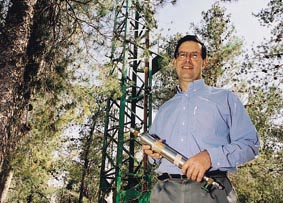Are you a journalist? Please sign up here for our press releases
Subscribe to our monthly newsletter:

About 6.5 billion tons of carbon are spewed into the Earth's atmosphere every year as carbon dioxide, or CO2 - the greenhouse gas believed to be largely responsible for global warming. Of this, some 1.5 billion tons dissolve in the ocean, but 2 billion additional tons are removed in an as yet mysterious way.
Evidence suggests that plants may be involved, but details of this vanishing act remain unclear. One scientist exploring this question is Prof. Dan Yakir of the Weizmann Institute's Environmental Sciences and Energy Research Department.
Greenhouse gases, so called because they trap heat, are in fact essential to life. When the sun's radiation hits the earth's surface, it's reflected back as infrared radiation. This radiation is then partly trapped by greenhouse gases, including carbon dioxide, methane, and water vapor. Without this natural effect, the Earth would be a pretty inhospitable place, with average temperatures nearing 0°F (18°C). The problem is one of balance. If too much heat is trapped, an increasingly warmer climate can have serious consequences, experts predict, including rising seas, severe weather patterns, and even a dramatic spread of infectious disease. And proof that this process may have begun is piling up. The Earth's surface temperature rose by about 1°F during the 20th century, accompanied by a 6-inch (15-centimeter) rise in sea levels, thinning arctic ice, and longer growing seasons.
Plants counteract this harmful build-up by converting part of the excess CO2 into glucose through photosynthesis. But how significant and sustainable is their impact? And to what extent is their beneficial effect offset by widespread deforestation, particularly in the world's rainforests? Solving these unknowns is essential for predicting climate changes and designing environmental strategies aimed at controlling the levels of greenhouse gases.
Prof. Yakir's past research led to a method for calculating the amount of carbon dioxide consumed globally by vegetation. It is well known that plants 'inhale' or absorb CO2; but Yakir zeroed in on their specific preferences. He found that they prefer carbon dioxide containing the light version of oxygen atoms, O16, rather than the heavier isotope O18, and that the amount of heavy oxygen left in the atmosphere reflects the extent of carbon dioxide consumption by plants.
But another angle needed to be addressed. Plants differ in the rate at which they consume carbon dioxide. For instance, most plants belonging to the C3 biochemical category, which includes tropical shrubs and trees, require high CO2 concentrations. However, savanna and prairie grasses belonging to the C4 biochemical category can thrive in relatively low CO2 levels. This explains why C4 plants accounted for roughly 40 percent of global vegetation activity during the last ice age, when atmospheric CO2 levels were about half of what they are today, whereas they now account for only 25 percent. In other words, the global activity of C4 plants can effectively indicate changes in atmospheric CO2 levels, offering a valuable addition to the limited arsenal of quantitative research tools available. Now a recent study by Yakir and postdoctoral fellow Dr. Jim Gillon suggests just how these indicators may be put to use.
As reported in Science, the researchers discovered surprising differences between C3 and C4 plants in the activity of carbonic anhydrase, an enzyme that is also important in human and animal breathing. Because these differences affect not only the quantity of atmospheric CO2 taken up by plants but also the amount of the O18 isotope left over, this discovery sets the stage for using O18 analyses in atmospheric CO2, as determined by a newly formed network of 50 research stations worldwide.
Based on these data, it is now possible to calculate the relative contribution of C3 and C4 plants to global vegetation activity. Initial calculations by Yakir's team show that C4 plants may today account for only 20 percent of this activity.
'The evidence of a significant change in global plant populations is consistent with predictions of climbing CO2 concentrations,' says Yakir. 'It's an important step toward a better understanding of the complex interactions between biological systems and the global climate.'
Prof. Dan Yakir's research is supported by the Sussman Family Environmental Research Center, the Minerva Stiftung Gesellschaft fuer die Forschung m.b.H., and the Avron-Wilstaetter Minerva Center for Research in Photosynthesis.